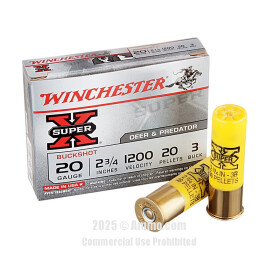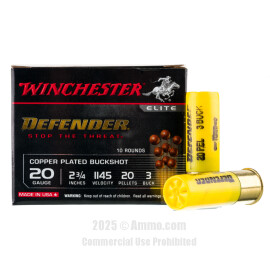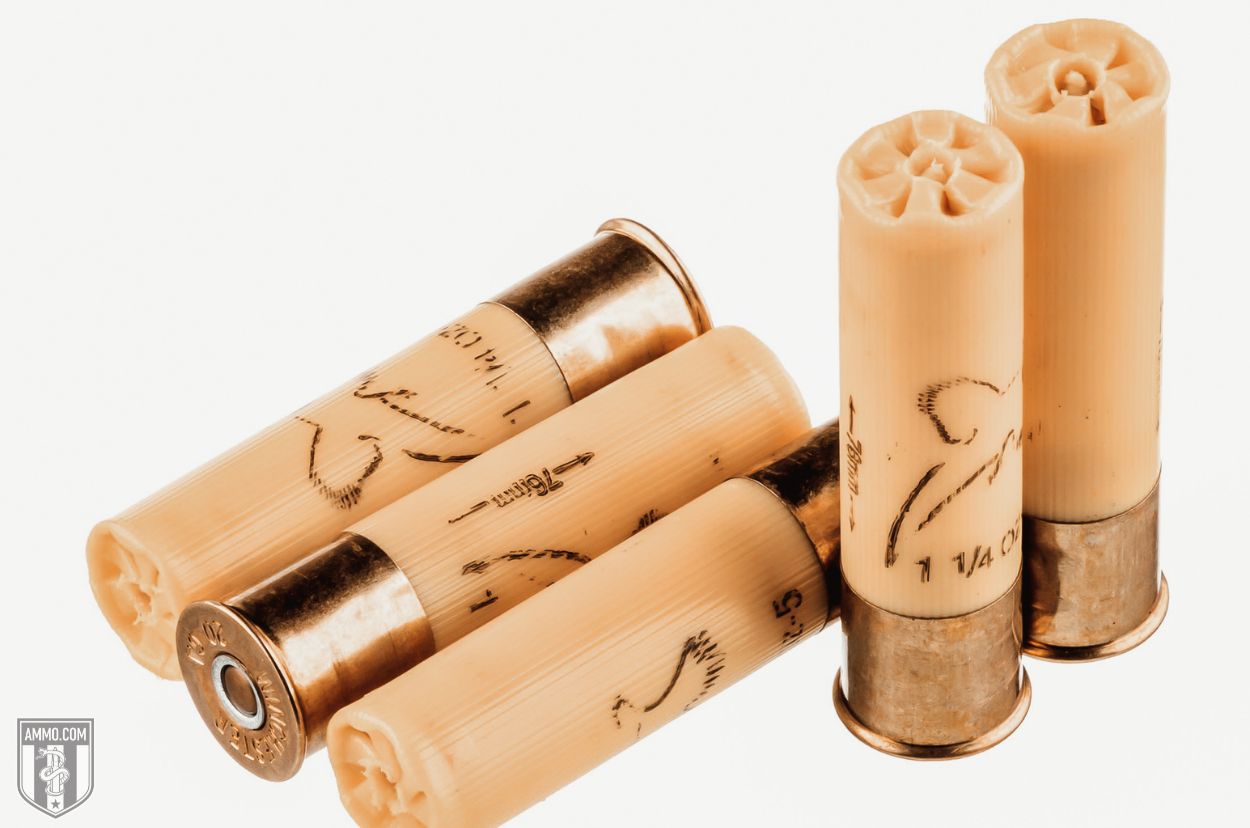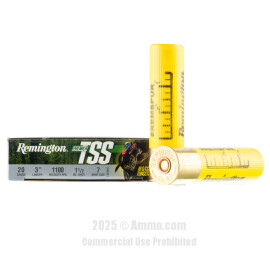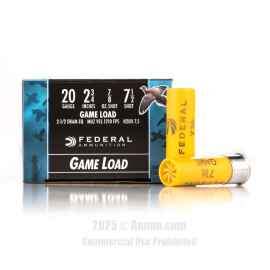The Best 20 Gauge Ammo for Home Defense, Whitetail, and Upland Game
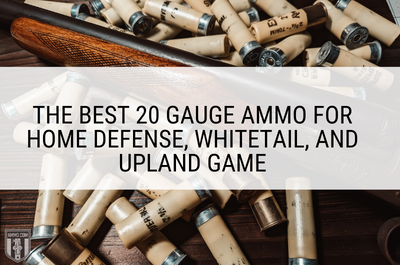
The 20 Gauge is often underrated. But even though it's not as powerful or popular as the 12 Gauge, it’s still an excellent option for sport shooting, hunting upland game or deer, and even home defense. It’s especially well suited to newer or smaller-framed shooters looking for something with less recoil.
A plethora of great 20 Gauge ammo choices are out there to choose from – so many, in fact, that choosing the right round can be difficult.
We’re going to fix that.
Below you’ll find all of the best 20 Gauge ammo options on the market. We’ve got picks for hunting (birdshot and buckshot), trap, skeet and sporting clays, good old-fashioned fun at the range range, and even self-defense. If you don't have time to wade through it, then I'll cut right to the chase: the best 20 Gauge ammo overall is Winchester Super-X #3 buckshot (with the caveat that it's only suitable for situations where buckshot is appropriate).
If you’re new to 20 Gauge ammo and want to learn more about how to pick the best ammo for your shotgun, check out our Buyer’s Guide HERE.
Top 5 Best 20 Gauge Ammo Picks
1) Winchester Super-X #3 Buckshot – Best Overall
2) Winchester Defender #3 Buckshot – Best for Self-Defense
3) Federal Premium TruBall Rifled Slug – Best Slug Ammo
4) Remington Premier TSS – Best Turkey Ammo
5) Federal Game Load Upland #7-1/2 Shot – Best for Upland Game
Best 20 Gauge Ammo Overall
Winchester Super-X #3 Buckshot
Specs
- Shot Load: 20x #3 Buckshot
- Length: 2-3/4
- Muzzle Velocity: 1,200 fps
Pros
- Very affordable
- Available in bulk
Cons
- Somewhat inconsistent patterning
- Might not cycle well in gas or inertia-operated guns.
Why We Chose It
Whether you’re blasting clays, hunting on the cheap, or just stocking up on ammo for the end of days (it'll be here any minute now, promise), it's hard to go wrong with Winchester Super-X.
From target loads and birdshot to slugs and high-brass buckshot, Winchester offers the ideal shotshell for any application. I'm showcasing one of the buckshot loads here, but really, they’re all solid options for buying cheap and stacking deep.
This particular 20 Gauge buckshot shell is a good budget hunting or home-defense option that’s unlikely to let you down, though it does lack a little bit when compared to higher-end ammo that’s more tailored to defense or deer hunting.
Still, Super-X is plentiful, affordable, and more than sufficient for most tasks. AIt’s the best on this list for turning money into noise at the range, which is a valuable attribute. This is by far the best 20 Gauge ammo for target shooting you’ll find (not counting any sort of clays, that is).
Best 20 Gauge Ammo For Home/Self-Defense
Winchester Defender #3 Buckshot
Specs
- Shot Load: 20x #3 Buckshot
- Length: 2-2/3
- Muzzle Velocity: 1,145 fps
Pros
- High velocity
- Ideal self-defense load
- Copper-plated shot
Cons
- More expensive than standard buckshot
Why We Chose It
12 Gauge shotguns may be the default scattergun choice for home defense, but the humble 20 Gauge makes for a great home defense shotgun, too – when loaded with modern, state-of-the-art ammo.
Winchester Defender is a high-brass round available loaded with segmented slugs, rifled slugs, or copper-plated buckshot. Whether you're hunting from a distance or covering the gap between yourself and the other end of your living room, there's an ideal Defender load for the job.
I chose #3 buckshot because it's large enough to neutralize a threat quickly, but also small enough to deliver a dense pattern. Twenty individual #3 buckshot pellets basically do the same job as a whole handgun magazine worth of bullets. One of these shells is more than enough for close-range threats.
This shell's copper-plated shot provides multiple performance advantages. It prevents deformation in the barrel that could have weakened pattern density, and also prevents deformation in soft tissue that could have shortened penetration depth. We didn’t get the recoil gauge out, but this ammo also seems to have lower felt recoil than some other analogous defensive options.
Best 20 Gauge Slug Ammo
Federal Premium TruBall Rifled Slug
Specs
- Bullet Weight: 328 Grain TruBall Hollow Point Slug
- Muzzle Velocity: 1,600 fps
- Muzzle Energy: 1,864 ft-lbs
- Length: 2-3/4
Pros
- Very high velocity
- 1.4” groups at 50 yards
Cons
- Not inexpensive
Why We Chose It
You have quite a few options when it comes to slugs, but none better than the Federal Premium TruBall Rifled Slug. This is a great slug option for smoothbore barrels, and is perfect for any medium game or self-defense. A ¾ oz lead slug is going to make any whitetail or home invader take notice pretty quickly.
Federal uses a plastic ball (the TruBall in question) to lock the slug into the wad, which helps perfectly center it with the bore line. That translates to a big increase in downrange accuracy, and also enables the wad and slug to separate cleanly at the muzzle.
This is a great option for anyone that wants more versatility out of a smoothbore 20 Gauge barrel, and is perfect for virtually any application that calls for a slug.
Best 20 Gauge Turkey Load
Remington Premier TSS
Specs
- Shot Load: 1.5 oz #7 or #9
- Length: 3"
- Muzzle Velocity:1,100
Pros
- High velocity
- Shot is denser than lead
Cons
- Expensive
Why We Chose It
Thanks to its tight pattern and ultra-dense shot load, Remington Premier Tungsten Super Shot (TSS) ammo is a favorite among turkey hunters who want to make every shot count. The specially designed ultra-dense tungsten pellets hit hard, and allow you to hunt with smaller pellets (and therefore denser patterns) than you could have with lead. Tungesten pellets are more than 50% denser than lead!
This ammo is expensive, but you absolutely will notice improved performance – well worth it if you hunt turkey rarely and want to secure your best odds of success. It's worth it even if you expect to take your tom at short range.
Check out our available stock of Remington 20 Gauge slugs or Fiocchi 20 Gauge ammo for more options.
Best 20 Gauge Ammo for Upland Game
Federal Game Load Upland #7-1/2 Shot
Specs
- Shot Load: 7/8 oz #7-1/2
- Length: 2-3/4
- Muzzle Velocity: 1,210 fps
Pros
- Low recoil
- Tight pattern
- Affordable
Cons
- Lead shot not allowed in all areas
Why We Chose It
Federal Game Load Upland #7-1/2 shot is an excellent choice for hunting upland game that won’t break your budget. These 20 Gauge shells produce a nice, tight pattern and are extremely effective on quail, dove, and any other birds you manage to track down.
Federal's 2-3/4" game loads have slightly less recoil than their other offerings, including Vital-Shok, Power-Shok, Hevi-Shot, and even Top Gun. These game loads have also proven themselves to be a great option for sporting clays. The Ammo.com team had a great afternoon exploding clay pigeons with them.
The only downside to these game loads is that they are loaded with lead shot, which is prohibited in some areas. Federal does offer steel game loads if you need them, you can't beat the traditional #7-1/2 shot load's price tag.
Parting Shots
There are a ton of great options out there for 20 Gauge ammo. Hopefully we’ve given you a good idea of what’s available and where to start your search.
Anyone going after larger game birds might be interested in Remington Premier TSS, whereas anyone looking for a low-recoil self-defense option should check out the Winchester Defender line. Budget-wise, it’s hard to beat good old Winchester Super-X in either birdshot or buckshot.
There are other great options out there that we haven’t covered here. Be sure to check out our full range of 20 Gauge ammo to see if there’s something else that might be better suited to your specific needs.
Don't forget to check out our Hornady 20 Gauge slugs page for more slug options.
20 Gauge Ammo Buyer’s Guide
Congratulations on your new 20 Gauge shotgun! I promise you are going to fall in love with this scatter gun, as all the different varieties of 20 Bauge ammo offer a ton of versatility without the punishing recoil of a 12 gGauge.
It doesn't matter if you got a classic pump-action like a Mossberg 500 or a beautiful Benelli 828 U over/under. We can help you pick the best ammo for your favorite new 20 Gauge shotgun!
Below is our Buyer’s Guide to help you understand how to pick the right shotgun ammo for your new 20 gauge.
What’s a Gauge? Shotgun Bore Size Explained
If you’re familiar with shotguns, you’ll know that a lower gauge means a bigger caliber. However, if you’re new to shotguns or firearms in general, this can be a confusing concept to grasp.
Handgun and rifle calibers are defined by their internal bore diameter. A .4 caliber handgun has 0.40" diameter bore. In this case, the bigger the number, the bigger the bullet the gun fires.
Shotgun gauges are determined by a more archaic system. Suppose you have 1 pound of lead. You form 20 equally sized spheres out of it, such that each sphere weighs 1/20 pounds. You place one of those spheres in the barrel of a 20 Gauge shotgun, and notice that it is the largest lead orb that can possibly fit inside there.
In fewer words, the diameter of an X Gauge shotgun's bore is equal to the diameter of a 1/X-pound lead ball. The 410 Bore shotgun, which has a bore diameter of 0.41", is the exception. It follows the same convention as conventional pistol and rifle barrels.
For reference, a 20 Gauge shotgun has a bore diameter of 0.615"; a 12 Gauge shotgun, 0.729".
Rifled vs. Smooth Bore: What Slugs to Buy?
When it comes to deer hunting, you cannot beat a slug for pure stopping power and terminal performance. And although everyone seems to gush over their beloved 12 Gauge deer guns, the 20 Gauge shotgun is an extremely effective whitetail terminating machine nevertheless.
Shotgun barrels come in two options: smooth bore, and rifled bore. Smooth bore shotguns are the more classic design and have no internal rifling. Rifled bore barrels have rifling similar to handguns and centerfire rifles, which helps stabilize slugs by imparting spin on the projectile.
However, purchasing slugs for your new 20 Gauge venison harvester can be confusing, as there are two varieties available: rifled, and sabot. Understanding which shotgun ammo goes with your barrel is critical for downrange performance.
Rifled slugs are designed for smooth bore shotguns.
These slugs have rifling on the projectile which serves no other purpose than to help the slug pass safely through a choke tube. Rifled slugs shout NOT be used in a rifled barrel, as that will cause leading, poor accuracy, and potential damage to the shotgun.
A sabot slug is essentially a large bullet. The bullet is held in a plastic cup that detaches shortly after expulsion from the muzzle. Sabot slugs are excellent for long-range shots, as their profiles are considerably more streamlined than rifled alternatives.
Sabot slugs are designed for rifled bore shotguns.
Sabot slugs can be safely fired from smooth bore shotguns, but doing so results in absolutely atrocious accuracy.
Birdshot vs. Buckshot: Shot Size Explained
The difference between birdshot and buckshot is the size of projectiles. Smaller shot pellets form denser patterns (because more can fit in a shell), but also tend to strike with less energy and penetrate to a shallower depth. Conversely, larger shot translates to fewer pellets per shell, with the upshot of higher striking energy and deeper penetration.
Read more about buckshot and birdshot here: Buckshot vs. Birdshot.
As its name implies, birdshot is primarily designed for hunting birds like quail, grouse, pheasant, duck, goose, and even turkey. Birdshot is also suitable for bagging small game like rabbit, squirrel, and even snake.
Although primarily developed for small game hunting, birdshot is also used for target shooting, such as skeet, trap and sporting clays.
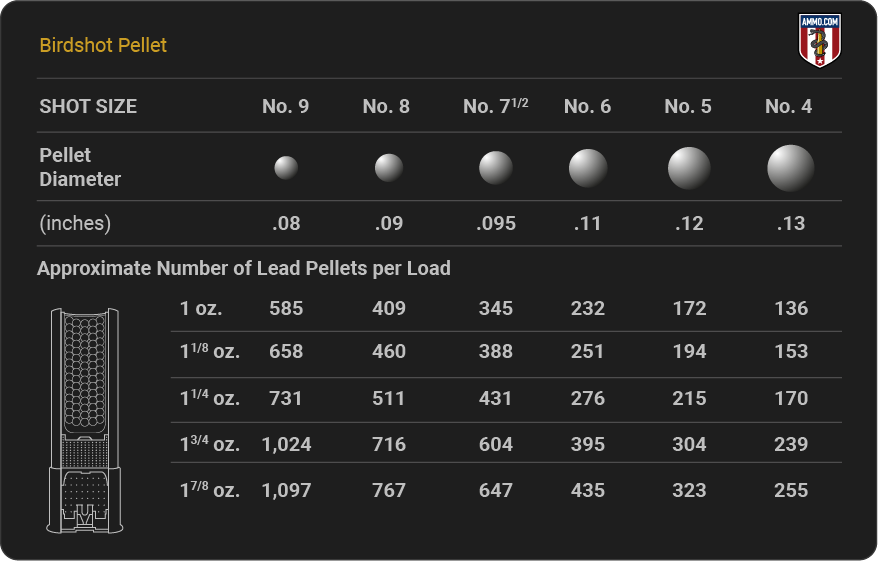
Shot size works on an inverse scale: the larger the number, the smaller the pellet. For example, #5 shot is larger than #8 shot. The most common birdshot sizes you’ll see at the ammo counter are #7, #7-1/2, #8 and #9, any of which can be used for upland game hunting or target shooting.
Although some birdshot loads can carry well over 500 pellets, these lightweight projectiles don’t carry a lot of kinetic energy. They therefore aren't suitable for taking very large game or home defense. For that, you’ll need something with a bit more oomph behind it – like buckshot.
Like its name implies, buckshot is designed for hunting medium and large game. Buckshot pellets are larger, which limits the number that can fit in a shell. Buckshot loads are often charged with more powder than birdshot ones, and have higher recoil, range, and penetration because of it. Buckshot typically has a tight pattern, whcih is optimal for harvesting big game.
Just like with birdshot, buckshot is measured in reverse. For example, #4 Buck is smaller than #1 Buck.

Buckshot is typically not used on birds or small game due to the amount of kinetic energy it carries. Using buckshot on a bird is considered, by many, unethical and typically renders the majority of the meat inedible.
Why Are 20 Gauge Shotshells Yellow?
You might already have noticed that virtually every 20 Gauge shotshell has a yellow hull. This is done to prevent accidents.
If you were to load a 20 Gauge shotshell into a 12 Gauge shotgun, it would slip down into the chamber where it would be difficult to see. If you then loaded a 12 Gauge shell and subsequently fired the shotgun – kerblooey – a shotgun-destroying explosion that could cost you a finger (or worse).
There is no industry mandate that all 20 Gauge shotgun ammo must be yellow. It's an unofficial standard that manufacturers universally follow for safety's sake.
To learn more about how 12 Gauge compares to 20 Gauge, check out this article: 12 Gauge vs. 20 Gauge.
What Shotgun Ammo Should You Buy? Buckshot vs. Birdshot vs. Slugs
Now that you have a better understanding of what types of 20 Gauge shotgun shells are available, let’s talk about what you should be loading into your scatter gun.
For general target shooting, sporting clays, or upland game, you’re going to want to get some game loads or birdshot. This type of shotgun ammo has low recoil and fires a lot of tiny pellets to give you a good pattern and a higher probability of hitting your target. These loads are typically filled with #7-1/2, #8, or #9 shot, and can be bought in bulk from companies like RIO, Fiocchi, Remington, Winchester, and Federal.
For home defense, buckshot is the best choice. A typical 20 Gauge shotshell filled with #3 buckshot contains around 20 pellets. When you squeeze the trigger, you are essentially firing the equivalent of twenty 0.25" caliber bullets at the same time. That will stop just about any threat pretty quickly. Multiple pellets also have the added advantage of increasing your chances of hitting vital organs and incapacitating the bad guy as quickly as possible.
For deer hunting, slugs are your best friend. Although buckshot is designed for big game hunting, many states and territories prohibit its use for that purpose. This is because at longer ranges, buckshot spreads out and increases the potential for only wounding a deer. Slugs, on the other hand, provide hunters with higher levels of accuracy at longer ranges, and also focus all the shotgun’s power into a single point. Slugs increase stopping power and reduce the potential for merely wounding the animal.
Shotgun slugs can be used for home defense. However, over-penetration is a big problem. A 20 Gauge shotgun slug is great when hunting in the woods where over-penetration doesn’t really matter, but when you're in civilization you need to consider the safety of family members and neighbors. A 20 Gauge slug is likely to pass through a home invader and several layers of drywall behind them, possibly hitting an innocent bystander or a loved one. It is our recommendation that buckshot should be primarily used for home defense over slugs.
Now that you know which shotgun ammo to buy, get back to our Top 5 List of the best 20 Gauge ammo available by clicking HERE!
Cartridge Recommendations
- Best Caliber for Deer Hunting
- Best Big Game Caliber
- The 10 Best Coyote Cartridges
- Best Cartridge for Elk Hunting
- Best Cartridge for Self-Defense
- Best Cartridge for Concealed Carry
- Best Handgun Cartridge
- Best Moose Cartridges
- Best 40 S&W Ammo For Self Defense & Target Practice
- Best 223 Ammo
- Best .44 Magnum Ammo
- Best 270 Ammo for Hunting
- Best 17 HMR Ammo for Varmint Hunting and Plinking
- Best 22 Rimfire Ammo
- 4 Best AK-47 Ammo Picks [7.62x39]
- Best 38 Special Ammo for Self Defense
- Best Handgun Ammo for Self-Defense in Common Calibers
- Best 308 Ammo For Hunting & Target Shooting
- Best 300 Win Mag Ammo
- Best 243 Ammo for Target Shooting
- 10 Best 6.5 mm Cartridges For Long-Range Shooting and Hunting
- Best 45 ACP Hollow Points for Self-Defense
- Best 12 Gauge Ammo for Home Defense
- Best 32 ACP Ammo for Your Pocket Pistol or Backup Gun
- Top 13 Best AR Calibers That Aren’t 5.56 NATO
- Best Ammo for Smith and Wesson M&P 9mm Shield
- Best 7.62x39 Ammo for Self Defense
- Best 20 Gauge Ammo for Home Defense, Whitetail, and Upland Game
- Best Ammo for 1911 45 ACP
- Best 12 Gauge Ammo for Deer Hunting
- Best .40 S&W Ammo for Self Defense
- Best 7.62x39 Hunting Ammo
- Best 5.56 Ammo for Home Defense
- Best 380 Self-Defense Ammo
- Best 45 ACP Ammo for Every Situation
- Best Ammo for Glock 43x
- Top 5 Best 22 WMR Ammo on the Market
- Best Ammo for Glock 19
- Best Sniper Ammo
- Best 38 Special Ammo For Target Practice Precision Shooting
- Top 5 Best 45 ACP Ammo for Target Practice
- Best 6.5 Creedmoor Hunting Ammo
- Top 10 Best Sniper Rifle Cartridges
- Best 6.5 Grendel Ammo
- Best 5.45x39 Ammo for Your Gun
- Best 10mm Ammo for Bear Defense
- Best 350 Legend Ammo
- Top 5 Best 30-06 Ammo for Deer Hunting
- Best 30-06 Ammo for Accuracy
- Best 300 Win Mag Ammo for Deer
- Best M193 Ammo for Stockpiling
- Best 300 Blackout Ammo for a 7.5" Barrel
- Best Shotgun Shells for Target Practice
- Best 45 ACP for Bear Defense
- Best 223 for Deer Hunting
- Best Exotic 9mm Ammo
- Best Duck Hunting Shells
- Best .357 SIG Defensive Ammo
- Best Beretta APX 9mm Ammo
- Best 22 Pistol Ammo
- Best 9mm Ammo
- Best 308 Ammo for Deer Hunting
- Best Ammo for the Taurus GX4
- Best Ammo For Taurus PT111 G2
- Best Shells For Trap Shooting
- Best 38 Special Ammo for Snubbies
- Best 410 Ammo For A Taurus Judge
- Best Ammo for Ruger Security 9
- Best Ammo for Taurus G3c
- Best 7mm Rem Mag Ammo
- Best Lead-Free Hunting Ammunition
- Best 300 Blackout Ammo for Hog Hunting
- Best 9mm Home Defense Ammo
- Best 10mm Ammo for Every Shooting Situation
- Best .22 LR Ammo for Self-Defense
- Best Long-Range Hunting Bullets
- Best 357 Magnum Ammo For Every Shooting Situation
- Best 45 ACP Ammo For Self-Defense
- Best 6.5 Creedmoor Ammo For Accuracy
- Best 45-70 Ammo For Hunting & Target Shooting
- Best Turkey Loads
- Deadliest Shotgun Ammo For Home Defense
- Best 300 Win Mag Ammo For Elk Hunting
- Best 9mm Subsonic Ammo
- Best 7mm PRC Ammo
- Best 300 Blackout Subsonic Ammo
- Best 308 Subsonic Ammo for Hunting
